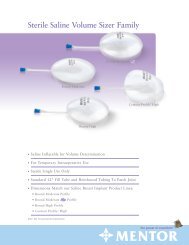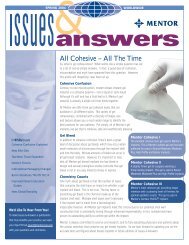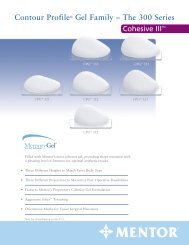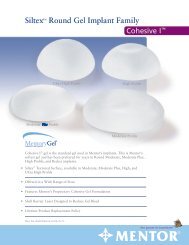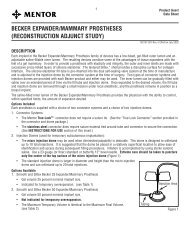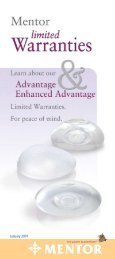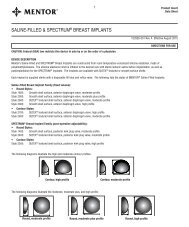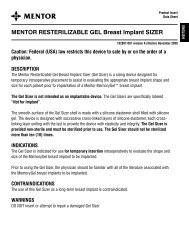Breast Reconstruction Patients Educational Brochure - Mentor
Breast Reconstruction Patients Educational Brochure - Mentor
Breast Reconstruction Patients Educational Brochure - Mentor
- No tags were found...
You also want an ePaper? Increase the reach of your titles
YUMPU automatically turns print PDFs into web optimized ePapers that Google loves.
356.2 <strong>Breast</strong> <strong>Reconstruction</strong> with Implants – Understanding the ProcedureThe surgical procedure for breast reconstruction with implants consists of choices youand your surgical team (surgeon(s), nurses, anesthetist, etc.) will make as you plan yoursurgery. If you are continuing treatment for cancer (like chemotherapy or radiation),your surgeon(s) should consult with your oncologist. For breast reconstruction, the typeof procedure that is available to you depends on your medical situation, breast shapeand size, general health, lifestyle, and goals for the reconstruction. The outcome of amastectomy will affect the amount of breast tissue left to cover a breast implant.<strong>Breast</strong> <strong>Reconstruction</strong> with Implants – Staging the Procedures<strong>Breast</strong> reconstruction is usually done in stages. It often takes more than one surgery. Aprimary (first) reconstruction after mastectomy is often started during the same surgeryas your mastectomy, but you may need follow-up surgeries to finish and make thereconstructed breast match the other breast. The stages may include• Putting in a soft tissue expander, an implanted silicone shell that can be filled with moreand more saline solution to slowly stretch your skin enough to allow it to cover an implant(more information is provided below),• Taking out the tissue expander and putting in a breast implant (silicone gel or saline-filled),• Surgery to adjust the shape and or size of the opposite breast so it matches thereconstructed breast, and• Nipple reconstruction (if you have a mastectomy, the nipple is usually removed; usuallya new nipple is created later, as an outpatient procedure after the initial reconstructionsurgery is finished; a nipple may be created using skin taken from the opposite breast oranother part of your body).Use of Tissue Expander(s) in <strong>Breast</strong> <strong>Reconstruction</strong> SurgeryPlacing a tissue expander may be one step in your breast reconstruction. If you are havinga mastectomy, the surgeon will remove breast tissue and also some skin. Afterwards, yourchest will be flatter and tighter. For many women (especially if you had small-to-medium-sizedbreasts before your mastectomy), there will not be enough skin and tissue to cover a breastimplant comfortably; the breast “pocket” (space for an implant) will be too small.Placing an implant in a breast pocket that is too small can cause complications such asdrooping or sagging at an earlier age, implant extrusion, skin wrinkling, infection, andhematoma. You may also be able to feel folds on the implant created by the implant beingsqueezed tightly by the surrounding skin and other breast-area tissue.Tissue expanders (also called soft-tissue expanders) are devices that are used whenthere is not enough skin or breast tissue to cover an implant. They are made of a siliconeelastomer (stretchy, rubbery silicone) shell like a breast implant but are empty of fillerwhen they are put in your breast. The tissue expander has a port (valve) that will lie underyour skin after it is placed. Your surgeon can then gradually fill the tissue expander withsterile saline solution (saltwater) over several weeks or months by injecting the salineinto the device through the port under your skin. As the device expands, it will cause yourbreast skin and tissues to stretch like a woman’s abdomen stretches during pregnancy.Eventually, the skin and breast tissue are stretched enough to create a space for yourbreast implant, as shown in Figure 2 below.A tissue expander can be placed at the time of your mastectomy or months or yearslater. Your reconstruction surgeon can tell you whether tissue expansion may benecessary in your case.The tissue expander is placed surgically, usually in an operating room under generalanesthesia. You may be able to go home the same day or may stay overnight at the hospital.Most women can go back to their usual activities within 2 to 3 weeks after the expander isplaced. If you have a tissue expander placed during the same surgery as your mastectomy,the breast tissues are usually numb from the mastectomy; you may not feel pain after the





